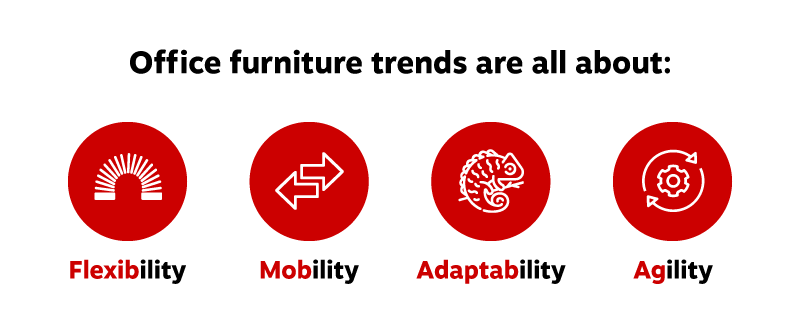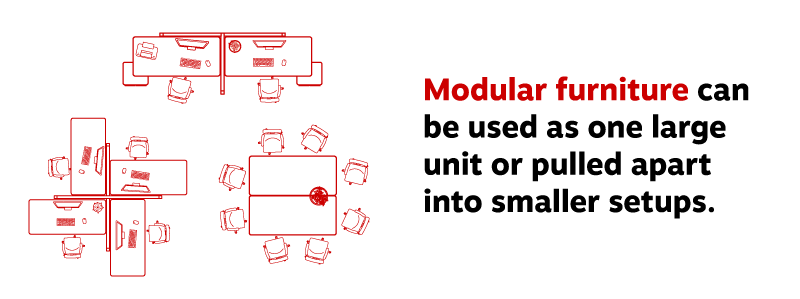Office Furniture Trends That Aren't Working
In years gone by, standard office furniture and stagnant layouts have dominated the workplace. Companies bought office furniture in bulk, meaning almost every employee had the same desk, chair, and setup. Rows and rows of desks in an open layout can feel
intimidating and uninspiring and many employees dislike this type of office layout. To improve office layouts, functionality, and overall employee comfort, we need to understand which furniture trends aren't working in the
modern workspace.
Cubicles
Cubicles have been a popular option for creating individual workspaces in a large area. But cubicles are rigid, inflexible, and mostly closed off from the rest of the office. Additionally, cubicles have enough space for one or two employees, so there
isn't room for group collaboration or an employee to spread out their work.
Fixed Furniture
Many office setups feature large, bulky furniture that is not easily mobile. Conference tables may be anchored in place and large, heavy desks can be too hard to shift. When furniture is fixed or too heavy, it prevents employees from being able to configure
the space to their needs.
Furniture for Function
Traditionally, office furniture has been purchased for function over comfort. Employees need desks, chairs, and a place to put their things; but usually, little consideration is given to making these workspaces customized to the employee. Offices were
designed to look professional instead of comfortable and welcoming.
Rigid Workstations
Workspaces shouldn't be a one-size-fits-all option. What works for one employee may not work for another, and identical desk setups promote a rigid working style that many employees are turning away from. Additionally, a stationary workstation keeps employees
in one spot for most of their day, which limits workplace flexibility and can hinder productivity.
Commercial Office Design Trends for 2022
At NeoCon, a commercial design industry trade show, the focus of the year was all about ability - flexibility, mobility, adaptability, and agility. Workspaces
need to be adapted to the way an employee works as well as the work that needs to be done.

Work with the Comforts of Home
After almost two years of remote working, many employees have grown accustomed to the comforts of home while clocked in. As some have transitioned back to the office and a hybrid work schedule, those comforts are appearing in furniture design trends for
the upcoming year. These are a few simple ways to make the office feel more like home:

Implement all of these options to create a softer, more relaxed workspace. Add comfortable couches to the breakroom, create relaxing areas where
employees can go to get away from their desks. Think of your employees as the focal point for your workspace changes and consider how their unique home and office workspace preferences might ladder up to being their most comfortable
and productive selves. As you bring more home comforts into the office, you get closer to the point where your employees are happier and more productive.
Sasha Barausky, Director of Merchandising at Staples, had this to say about the future of office furniture trends. "Office furniture doesn't have to be stagnant - it should be flexible and adaptable to the employees and the work they do. The more employers
can bring home comforts into the office, the closer they get to employees being more satisfied, comfortable, and productive in the workplace." Michelle Kuzila, Director of Product Development for furniture at Staples added,
"this adaptability is like a triangle, with the office and home at the bottom points and the employee at the top as the central focus." Keep this in mind as you make updates to your office to ensure your changes are better
match employee wants and needs.

Flexibility and Mobility
At home, employees can move to different workspaces throughout their day. Perhaps they start at the kitchen table for morning meetings before moving to the couch for a more relaxed and comfortable environment while they work on another task. This mobility
is showing up more in office furniture trends as companies are creating different work areas outside of the standard desk and chair. Companies can invest in
mobile workstations, comfortable seating,
adjustable desks, and work tables throughout the office.

The ability to move around to various workspaces doesn't just mimic the work-from-home experience, it is also beneficial for employee health and productivity. According to an article from
Harvard Business Review, "the ability to create and control one's entire day as the needs of work dictates puts
employees squarely in control of their own time management, productivity, and processes. This has been shown to lead to greater organizational productivity and suggests that meeting an employee's need for autonomy can influence
motivation and performance." This means that when employees can step away from a stagnant desk and move to a new, comfortable workspace, they may also be able to concentrate better and produce higher-quality work.

Catering to the Hybrid Workforce
The future of office work is the hybrid work model - a combination of remote and in-office workdays that allow employees more work flexibility. In a recent
study, "....only 1% of HR leaders surveyed expect all of their employees to work full-time in the office."
Hybrid work is going to be a part of the workplace moving forward To accommodate the flexible working locations, many companies
are doing away with assigned desks and structured workspaces. Instead, company owners are shifting to rotating schedules with shared workstations or a hot-desking model where employees work at any available desk or sign up
for a specific station through an online app. When multiple employees are using one workspace, it needs to be easily adaptable to multiple users.
Company Collaboration
Hybrid schedules and remote workers increase the need for functional collaboration. Video conferencing apps like Zoom, Microsoft Teams, and Google Meet make it easy to connect with multiple people in different locations. However, with in-office employees
and remote workers meeting together, video chats can place people at different visual levels and make the process feel disjointed.
At Microsoft, they have been working "...to design the conference room of the future, a new kind of software-infused
meeting space where in-person and remote participants could collaborate on an equal playing field." They have created a new content layout design that moves video participants to the bottom of the screen so they are at eye
level with people in the office. This video chat layout is likely to become a conference room staple in 2022 and beyond.
Another way to enhance in-office collaboration is modular office furniture. These are desks, tables, chairs, and other items that can be used
as one large piece or pulled apart into smaller breakouts. Large teams can meet together as one or break off into smaller groups without having to move to different rooms or find available space to meet.

Current Furniture to Future Function
Companies don't have to completely overhaul their office furniture to match 2022 trends. Instead, current furniture can be used in new ways. Do you have couches in your lobby that are rarely used? Move them to employee areas instead. Smaller tablesin
the breakroom can be swapped with a conference table and the breakroom tables can be used in employee collaboration areas. The idea is to look at what is currently working in the space and find what you can adjust to improve
comfort, flexibility, and functionality.
Planning Your Office Furniture for 2022
To easily implement these trends in your office, you need to consult your employees, think about how you would want to work, consider new office layouts, and embrace flexible and collaborative technology.
Cater to Employee Needs
Employees know which comforts they want in the office. Use a poll of employee opinions to ensure choices will cater to your employees' specific needs.
Imagine Your Own Workspace
Take a minute to think about how you worked while at home. Did you move around a lot? Did you work from the couch or your bed when you needed a comfortable space? If you work a hybrid schedule, what makes working easier for you?
Use your own work-from-home experience to find ways to bring home into the office. When you put yourself in your team's shoes, you can make a functional, more fluid work environment for everyone in the office.
Rethink the Office Layout
Your pre-pandemic office layout may not be as functional anymore as employees return to the office. You likely have fewer employees in the office each day, but you still may need to consider increasing office space to accommodate new comfort areas in
the office.
You want an office layout that allows for comfort, flexibility, and mobility while having a good balance of private and communal
workspaces that increase productivity and inspire collaboration.
Work With Office Furniture Experts
Staples can help implement 2022 furniture trends in your current workspace. With experience in working with large-scale companies to update offices, we coordinate our furniture recommendations down to the task and match new furniture trends to what your
workforce values most. Our Staples Advantage team is ready to help you customize your workspace and meet some of the new office design challenges as you adapt your working environments.
Contact Us for Workspace Customization
Office Furniture Trends of the Future
Furniture is the foundation of office design and is the number one issue companies can solve when creating more comfortable, flexible, and collaborative office layouts. Implement 2022 furniture design trends into your office and you'll be well on your
way to creating a better workspace for all.




















































